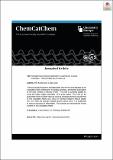Files in this item
Homogeneous (de)hydrogenative catalysis for circular chemistry – using waste as a resource
Item metadata
| dc.contributor.author | Kumar, Amit | |
| dc.contributor.author | Gao, Chang | |
| dc.date.accessioned | 2021-12-30T00:37:50Z | |
| dc.date.available | 2021-12-30T00:37:50Z | |
| dc.date.issued | 2021-02-18 | |
| dc.identifier | 271446173 | |
| dc.identifier | 1541ff04-c79f-41e7-9f94-54cab0e70ab7 | |
| dc.identifier | 000603416200001 | |
| dc.identifier | 85098292053 | |
| dc.identifier.citation | Kumar , A & Gao , C 2021 , ' Homogeneous (de)hydrogenative catalysis for circular chemistry – using waste as a resource ' , ChemCatChem , vol. 13 , no. 4 , pp. 1105-1134 . https://doi.org/10.1002/cctc.202001404 | en |
| dc.identifier.issn | 1867-3880 | |
| dc.identifier.other | RIS: urn:14B5808623F697A8B4C4E603B109099D | |
| dc.identifier.uri | https://hdl.handle.net/10023/24586 | |
| dc.description | AK thanks the Leverhulme Trust for an Early Career Fellowship. Featured in the Young Researchers Series. | en |
| dc.description.abstract | Increasing production and usage of several consumer products and energy sources have resulted in the accumulation of substantial amount of waste products that are toxic and/or difficult to biodegrade, thus creating a severe threat to our planet. With the recently advocated concepts of circular chemistry, an attractive approach to tackle the challenge of chemical waste reduction is to utilize these waste products as feedstocks for the production of useful chemicals. Catalytic (de)hydrogenation is an atom-economic, green and sustainable approach in organic synthesis, and several new environmentally benign transformations have been reported using this strategy in the past decade, especially using well-defined transition metal complexes as catalysts. These discoveries have demonstrated the impact and untapped potential of homogeneous (de)hydrogenative catalysis for the purpose of converting chemical wastes to useful resources. Four types of chemical waste that have been (extensively) studied in recent years for their chemical transformations using homogeneous catalytic (de)hydrogenation are CO2 , N2O, plastics, and glycerol. This review article highlights how these chemical wastes can be converted to useful feedstocks using (de)hydrogenative catalysis mediated by well-defined transition metal complexes and summarizes various types of homogeneous catalysts discovered for this purpose in recent years. Moreover, with examples of hydrogenative depolymerisation of plastic waste and the production of virgin plastic via dehydrogenative pathways, we emphasize the potential applications of (de)hydrogenation reactions to facilitate closed-loop production cycles enabling a circular economy. | |
| dc.format.extent | 2815434 | |
| dc.language.iso | eng | |
| dc.relation.ispartof | ChemCatChem | en |
| dc.subject | Homogenous Catalysis | en |
| dc.subject | Pincer | en |
| dc.subject | Circular chemistry | en |
| dc.subject | Plastic | en |
| dc.subject | Carbon dioxide | en |
| dc.subject | Green chemistry | en |
| dc.subject | QD Chemistry | en |
| dc.subject | SDG 8 - Decent Work and Economic Growth | en |
| dc.subject | SDG 12 - Responsible Consumption and Production | en |
| dc.subject.lcc | QD | en |
| dc.title | Homogeneous (de)hydrogenative catalysis for circular chemistry – using waste as a resource | en |
| dc.type | Journal item | en |
| dc.contributor.sponsor | The Leverhulme Trust | en |
| dc.contributor.institution | University of St Andrews. School of Chemistry | en |
| dc.identifier.doi | 10.1002/cctc.202001404 | |
| dc.description.status | Peer reviewed | en |
| dc.date.embargoedUntil | 2021-12-30 | |
| dc.identifier.grantnumber | ECF-2019-161 | en |
This item appears in the following Collection(s)
Items in the St Andrews Research Repository are protected by copyright, with all rights reserved, unless otherwise indicated.

